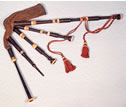 |
Henderson Co., Scotland, 1945; CMC 72-717
Pipe Major Sam Scott, to whom these pipes belonged, was perhaps Canada's most famous piper. A member of the Cameron Highlanders of Ottawa, when they went overseas with the Canadian Army, after the Second World War broke out in 1939, he took this Scottish Highland bagpipe with him. He piped Canadian troops onto the Normandy beaches on D-Day and served in the European Theatre throughout the war. Major Scott's pipes were acquired by the Canadian Museum of Civilization after his untimely death in an automobile accident in 1972.
Many people believe that only the Scots play bagpipes; but, in fact, they are a musical instrument known in many parts of the world. Bagpipes known as the gaida are still played in Bulgaria and in other parts of the Balkans, for example, and the pipes are also played in parts of Arabia, in Spain, France and the Ukraine. In Ireland, they play special bagpipes which are not blown, but actually pumped by the elbow alone. All bagpipes have drones and a double-reed chanter.
In Canada, we tend to think of bagpipes as the Highland variety, with several drones and a chanter which is fingered by the piper to make the melody. Inside the chanter is a double reed, much like the reed of an oboe or bassoon. The two parts of the reed vibrate together to make the characteristic tone. Highland bagpipers have led soldiers into battle for centuries, and the harsh sound has alternately thrilled and terrified friend or foe. You can see why First World War Scottish soldiers, with their screaming pipes and swinging kilts, were nicknamed "The Ladies from Hell".
Text: Phil Tilney
|

![]()

![]()